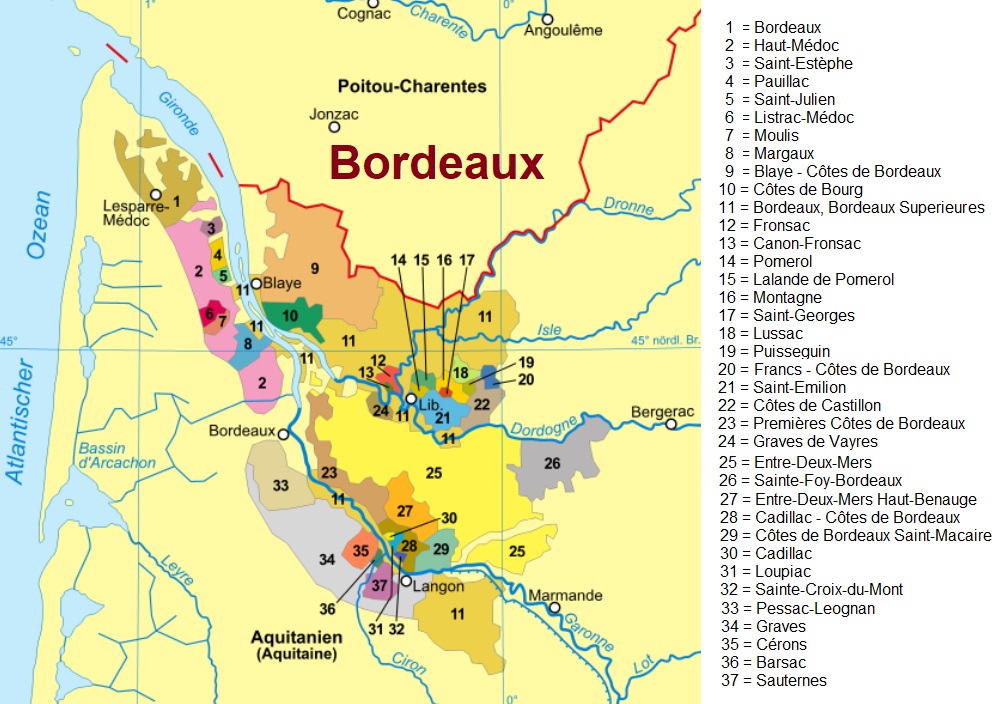Results
2,284 Results
Loading more Results ...
Loading more Results ...
| Graves AOC |
Description to Graves AOC
The Graves area in the Bordeaux region is an ancient wine-growing region. The Romans planted vineyards here as early as the 1st century and the Roman author Columella (1st century AD) wrote enthusiastically about the age-worthy wines. Around 1300, the Archbishop of Bordeaux (later Pope Clement V) founded a vineyard that still exists today under the name Château Pape-Clément. The fame of Bordeaux was co-founded by the wines from Graves.

At the end of the 19th century, the vineyard area was still around 10,000 hectares, but in the last hundred years many vineyards have been lost due to the growth of the city of Bordeaux. Even today, however, Graves still encompasses the urban area (the Châteaux Haut-Brion, La Mission and Les Carmes are located in a suburb). The vineyards stretch 50 kilometres south from Bordeaux and cover around 4,650 hectares, of which the Graves regional appellation covers around 3,000 hectares. The three appellations Barsac, Cérons and Sauternes are embedded in the south as enclaves. The area to the north, formerly known as Haut-Graves, where all the better châteaux are located, became the Pessac-Léognan appellation in 1987.
Soil type & grape varieties
The name Graves first appeared in the Middle Ages and is derived from the gravelly soil (terre graveleuse). The pebbles are collected and placed next to the vines. They store the heat of the sun during the day and release the heat to the grapes late into the night. This promotes the ripening process in a natural way and increases the sugar content of the grapes. Another special feature are the rose bushes that are planted at the end of each row of vines. In the past, this was not done for visual reasons, but as an early warning of diseases (e.g. fungal diseases). Two thirds of the vines are red and one third white.
Exceptional red, white and sweet wines are produced in the Graves appellation. The white wines are blended from Sauvignon Blanc, Sémillon with a little Muscadelle and Merlot Blanc. They are predominantly vinified dry and fresh. The red wines are produced from Cabernet Sauvignon, Cabernet Franc and Merlot, whereby the cuvées vary greatly from château to château. These are the typical grape varieties of the Rive gauche (left bank). The Graves Supérieures appellation, which covers 500 hectares, mostly describes sweet, but also dry white wines with a higher alcohol content.
Cru Classé des Graves
Château Haut-Brion was the only wine estate not located in the Médoc to be included in the Bordeaux classification in 1855. In 1953 and 1959, a separate classification for red and white wines was introduced for Graves (also including Château Haut-Brion). There is no ranking, only an alphabetical order. These châteaux are now all located in the Pessac-Léognan sub-region, which was separated in 1987. The designation of the wines is "Cru Classé des Graves".

Red wines
- Château Bouscaut (Cadaujac)
- Château Carbonnieux (Léognan)
- Château de Fieuzal (Léognan)
- Château Haut-Bailly (Léognan)
- Château Haut-Brion (Pessac)
- Château La Mission Haut-Brion (Talence)
- Château La Tour-Haut-Brion (Talence)
- Château La Tour-Martillac (Martillac)
- Château Malartic-Lagravière (Léognan)
- Château Olivier (Léognan)
- Château Pape-Clément (Pessac)
- Château Smith-Haut-Lafitte (Martillac)
- Domaine de Chevalier (Léognan)
White wines
- Château Bouscaut (Cadaujac)
- Château Carbonnieux (Léognan)
- Château Couhins (Villenave-d'Ornon)
- Château Couhins-Lurton (Villenave-d'Ornon)
- Château La Tour-Martillac (Martillac)
- Château Laville-Haut-Brion (Talence)
- Château Malartic-Lagravière (Léognan)
- Château Olivier (Léognan)
- Domaine de Chevalier (Léognan)
further information
In France, there is a bewildering variety of classification systems for wines, vineyards and appellations. This is even the case within a single region, particularly in Bordeaux. In addition to Graves, there are those of Médoc, Saint-Émilion and Sauternes. There is a consistent system in Burgundy. See also under Grand Cru and quality system.
Map: By Domenico-de-ga from Wikipedia, CC BY-SA 3.0, Link
Modifications from the original by Norbert Tischelmayer 2017
Château Haut-Brion: By BillBl - originally posted to Flickr as Chateau Haut-Brion, CC BY 2.0, Link
Château Smith-Haut-Lafitte: By Benjamin Zingg, Switzerland - Own Work, CC BY-SA 2.5, Link
Recent wines 37
 Domaine du Salut
— Bordeaux
2022 Graves AOC Rouge
14.00 €
Domaine du Salut
— Bordeaux
2022 Graves AOC Rouge
14.00 €

 Chateau Respide - SCEA Vignobles P. Bonnet
— Bordeaux
2021 Graves AOC Rouge
11.50 €
Chateau Respide - SCEA Vignobles P. Bonnet
— Bordeaux
2021 Graves AOC Rouge
11.50 €

The most important grape varieties
More information in the magazine
- Good Bordeaux doesn't have to be expensive! Crus Bourgeois
- Liv-ex Power 100: Bordeaux The number of brands in the top 100 has fallen to a new low
- Château Léoville Barton Saint Julien, 1997 Bordeaux, France
- Château Latour à Pomerol Latour à Pomerol 1981, Pomerol, Bordeaux, France
- Château Pichon Longueville Baron Les Tourelles de Longueville 1996, Pauillac, Bordeaux, France
- Château Beychevelle Beychevelle 2000, Saint Julien, Bordeaux, France
- Châteaux Ausone Ausone 1997, Saint-Emilion Grand Cru, Bordeaux
- Château Léoville Poyferré Saint Julien, 1997, Bordeaux
- Château de Monbousquet Angélique de Monbousquet 2008, Saint Emilion, Bordeaux
- Château Laujac Laujac 1996, Cru Bourgeois, Médoc, Bordeaux, France

